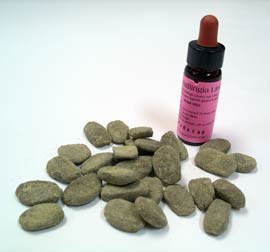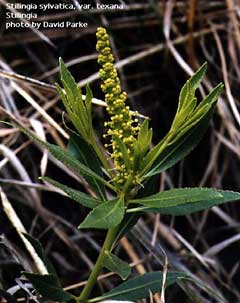Lozenges from Compound Liniment of Stillingia
Lozenges, also known as troches, are seldom made by the practitioner any more. Custom made lozenges offer our clients very specific remedies that release slowly. They treat mouth and throat issues exceedingly well and allow small amounts of medicine to have maximal effect.
Usually some combination of powdered herb, herb extract, and sugar is mixed with a mucilage until it has a dough like consistency, then shaped into lozenge form and dried.
Mucilage of acacia gum or tragacanth gums are most often used. Tragacanth gum is harder to work with and gives a better consistency to the finished lozenges. Acacia gum is easier to work with and yields a fine result.
Stillingia Liniment Lozenges
- 37 grams licorice root powder, well sifted
- 35 grams powdered slippery elm, well sifted twice
- 25 grams acacia gum as powder or whole pieces
- 2 drachms, 7.393 ml., or 7.8 grams of Compound Liniment of stillingia (one bottle). Available from Eclectic Institute
- 60 drops vanilla extract
- two small bowls, a medium size bowl, a fork, spoon, a scale
Prepare the mucilage of acacia in a small bowl: place the acacia gum in 50 ml. of water If you are using whole pieces agitate every hour until dissolved. This can take 10-12 hours. If using acacia gum powder, whisk powder into water with a fork for a few minutes, let rest 20 minutes and whisk again, repeat every 20 minutes until all the powder is dissolved.
Place compound liniment of stillingia and vanilla extract in medium sized bowl Add enough mucilage of acacia (see preparation instructions below) to compound liniment of stillingia and vanilla to make 70.5 grams. Mix well and set aside.
Sift together 17 grams of pre-sifted licorice root powder and 35 grams of the pre-sifted slippery elm powder. Place remainder of licorice root powder in a separate bowl and set aside. Slowly add powdered herb mixture into fluid mixture until it weighs 122.5 grams.
Mix well with a spoon or spatula, then kneed for a minute or two until it has a homogenous dough like texture.
Divide the dough into 245 1/2-gram egg or football shaped balls. Each lozenge contains 2 drops of compound liniment of stillingia
Gently flatten to a pleasant shape. (If the lozenge dough sticks to your fingers you may coat your fingers in licorice root powder, or coat your fingers with a no stick cooking spray to facilitate ease in preparation.)
Place the lozenges in the bowl of licorice root powder. Shake gently until covered. Place individual lozenges on a raised screen to dry.
Variation: Substitute 15 grams of finely powdered osha root (ligusticum porteri) for a 5 gram reduction of licorice root powder, and a 10 gram reduction of slippery elm powder
Preparation Notes
The mucilage has two uses in the preparation:
- As a binder it glues the lozenges together.
- As the lozenge dissolves, the mucilage coats the mouth, throat, and esophagus where it soothes irritation. It also holds the other medicines in place on the mucosa allowing for a stronger topical effect, and more mucosal absorption.
Mixing all the fluid ingredients before adding them to the premixed powders insures that the remedy is evenly distributed throughout the lozenges. If this precaution is not observed some lozenges may have more acacia mucilage but little compound liniment of stillingia, and some lozenges will have too much of the most active ingredients. Premixing the fluid and solid ingredients separately insures that each lozenge has a uniform and predictable strength, action and dosage.
The powdered herbs in this preparation can be replaced by sugar. If you make it that way use mucilage of tragacanth and adjust proportions appropriately. Licorice and slippery elm are chosen here for there medicinal effects of soothing , and bringing down inflammation in the mucosa and because they partially blunt and cover the sharp flavors of Compound Liniment of stillingia.
Powder coating and drying
If you live in the high deserts as I once did, simply place these lozenges on a raised screen in the shade. Low humidity, and low air pressure makes for quickly drying lozenges ( I've never seen herbs dry faster than when I lived in Bisbee AZ, 5500 ft. elevation.) If you are preparing the lozenges someplace humid and cool like Oakland California or wet, dank and fungal 9/10ths of the year like Olympia, WA, a food dehydrator set on 95F may be necessary, and will give you finished lozenges in under 2 days.
Place the freshly shaped wet lozenges in a bowl of powdered licorice or other good tasting herb. Toss gently to coat heavily.
Gently so as not to shake off too much powdered coating, place lozenges on a drying screen, or on food dehydrator trays in the food dehydrator. Keep temperature below 100 Degrees Fahrenheit. Dry until brittle. Place in mesh screen and agitate until most of the coating powder comes off.
During drying with forced air, the thick powdered coating, much like the pubescence or fuzz on a plant leaf on a windy day, prevents moisture loss from the surface. This helps keep the volatile oils in this preparation from being unnecessarily dissipated during the drying process.
Lozenges shape and size should be small enough to tuck comfortably between the gums and the buccal wall (inside of the cheeks). 1/2 gram lozenges weight un-dried is small enough to do this comfortably. These lozenges can take up to an hour to dissolve in the mouth.
Medicinal Actions, Indications and Contraindications Dosage
This remedy rocks. The first remedy to think of for a dry hoarse, spasmodic cough from throat irritation, from too much speaking or singing. It is excellent in the acute stages of laryngitis. It will speed someone through the recuperative stages quickly. Often dry spasmodic coughs are fully relieved for 48 hours by just 1-2 lozenges. It is helpful in bronchitis and sore throats that feel full and obstructed due to swollen fauces. The client will swallow often trying to clear the thick full feeling in the back of the throat, as if trying to clear mucus.
Stillingia is a strong stimulant to immune cells, and this remedy may be contraindicated for people on standard immune altering pharmaceuticals. The contraindications for the variation with Osha root are cultural. Osha root and many other ligusticum species are used ceremonially in numerous Native American cultures. Depending on the culture, time of year, and ceremony this remedy may be preferred by Native ceremonial singers or it may be inappropriate, or no issue at all either way.
Take no more than 4 lozenges a day.
Pharmacodynamics and Absorption
This remedy works topically and systemically.
Topical
With topical remedies dosage equals duration. The longer the remedy is in contact with the surfaces being treated the more effect. The slippery elm, and acacia gum mucilages mechanically soothe, protect and lubricate the mucosa they come into contact with. Lessening irritation of the throat lessens reflex coughing. Acacia gum mucilage is especially tenacious in clinging to mucosa for a longer time than most other herbal mucilages. They hold the licorice in place on the mucosa allowing it to have more local effect as an anti-inflammatory, immune stimulant and anti-viral. The stillingia, lobelia and cajeput oil have more time to stimulate circulation, appropriate secretion, and immune cell circulation and activity.
Systemic
A great deal of the stillingia, lobelia, and cajeput is absorbed through the buccal mucosa (inside of the cheek). The buccal mucosa are more permeable than even the mucosa under the tongue. Significant amounts of stillingia, lobelia, and cajeput are also absorbed in the rest of the mouth, under the tongue, and through the mucosa of the throat, and upper esophagus. As it moves through the mucosa, it has local effects,and winds up in the local venous blood which goes directly to the heart, unlike lower gastrointestinal tract venous blood which goes to the liver before returning to the heart. Bypassing the degradation of the liver on first pass allows this remedy to have more effect at a lower dose.
History of the Remedy
I've been making these lozenges since 1991. I found a recipe for Compound Liniment of stillingia lozenges with an acacia and sugar base in the spring. 2002 in John Scudder's writing. Numerous references to this lozenge were made in Eclectic journals. Lloyd Brothers produced them starting around 1884.
Preparing Compound Liniment of stillingia as a lozenges is an obvious choice. I am humbly encouraged to have come up with on my own a preparation previously conceived of by the giants of my lineage, John M. Scudder and John Uri Lloyd.
None of this would have been possible without the modern work of David C. Lyttle, herbalist and plant chemist extraordinare formerly of the Eclectic Institute in Sandy, Oregon.
David Lyttle researched and recreated Compound Liniment of stillingia, the heart of this remedy, from John Uri Lloyd's professional notes and personal journals. David Lyttle also recreated Lloyd's Specific Echinacea, having recreated the famous Lloyd Extractor. He also kindly sent me the excerpts and an advertisement from the Eclectic journals.
Compound Liniment of Stillingia is under used but could not be overrated in it's excellent effects. If you don't know this remedy, get some and try it. It is not widely available in retail stores, but can be ordered by contacting Eclectic institute at customerservice@eclecticherb.com. They prefer to sell this remedy to “health professionals”, and they define this term in a way that is broadly inclusive.


